Competitive Strategy Report: Analysis of Zara, Puma, and H&M (HI6006)
VerifiedAdded on 2023/02/01
|14
|3083
|41
Report
AI Summary
This report provides a comprehensive analysis of the competitive strategies employed by Zara, Puma, and H&M. The analysis utilizes key strategic tools, including PESTLE analysis to evaluate macro-environmental factors, SWOT analysis to assess internal strengths and weaknesses and external opportunities and threats, Porter's five forces model to understand industry attractiveness, and generic strategies to determine competitive advantages. The report examines how each company adapts its strategies to attract and retain customers, considering market entry factors and competitive landscapes. The findings highlight the distinct approaches of each brand, offering recommendations for strategic planning and sustainable competitive advantage. The application of these tools helps in analyzing the current position of the company and determining the macro-environment factors that influence the performance of the company. The frameworks help in designing effective strategies that promote the growth of the organization and helps in sustaining its competitive advantage. The application of the tools on Zara, Puma, and H&M will enhance the brand image and profitability of the company.
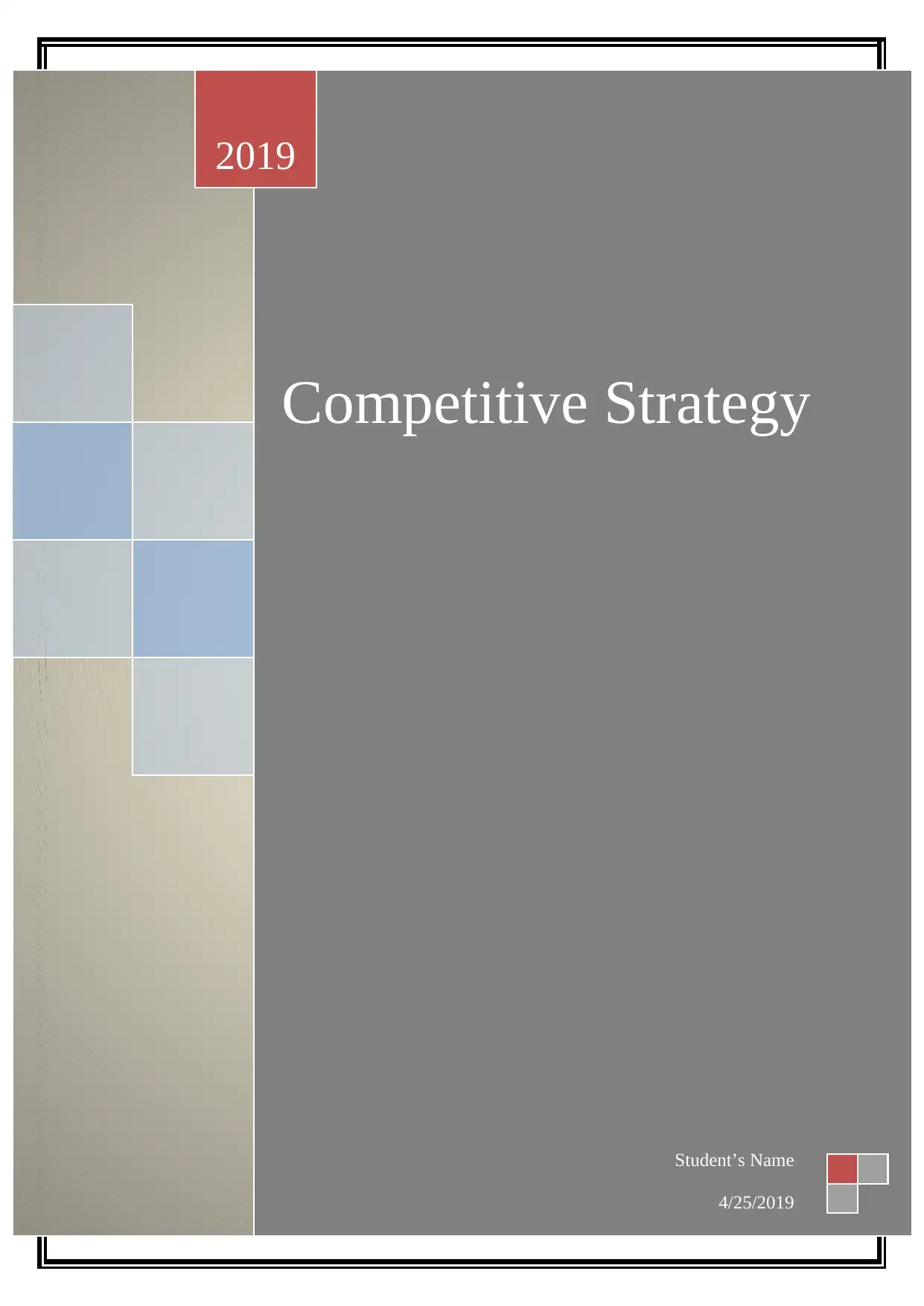
Competitive Strategy
2019
Student’s Name
4/25/2019
2019
Student’s Name
4/25/2019
Paraphrase This Document
Need a fresh take? Get an instant paraphrase of this document with our AI Paraphraser
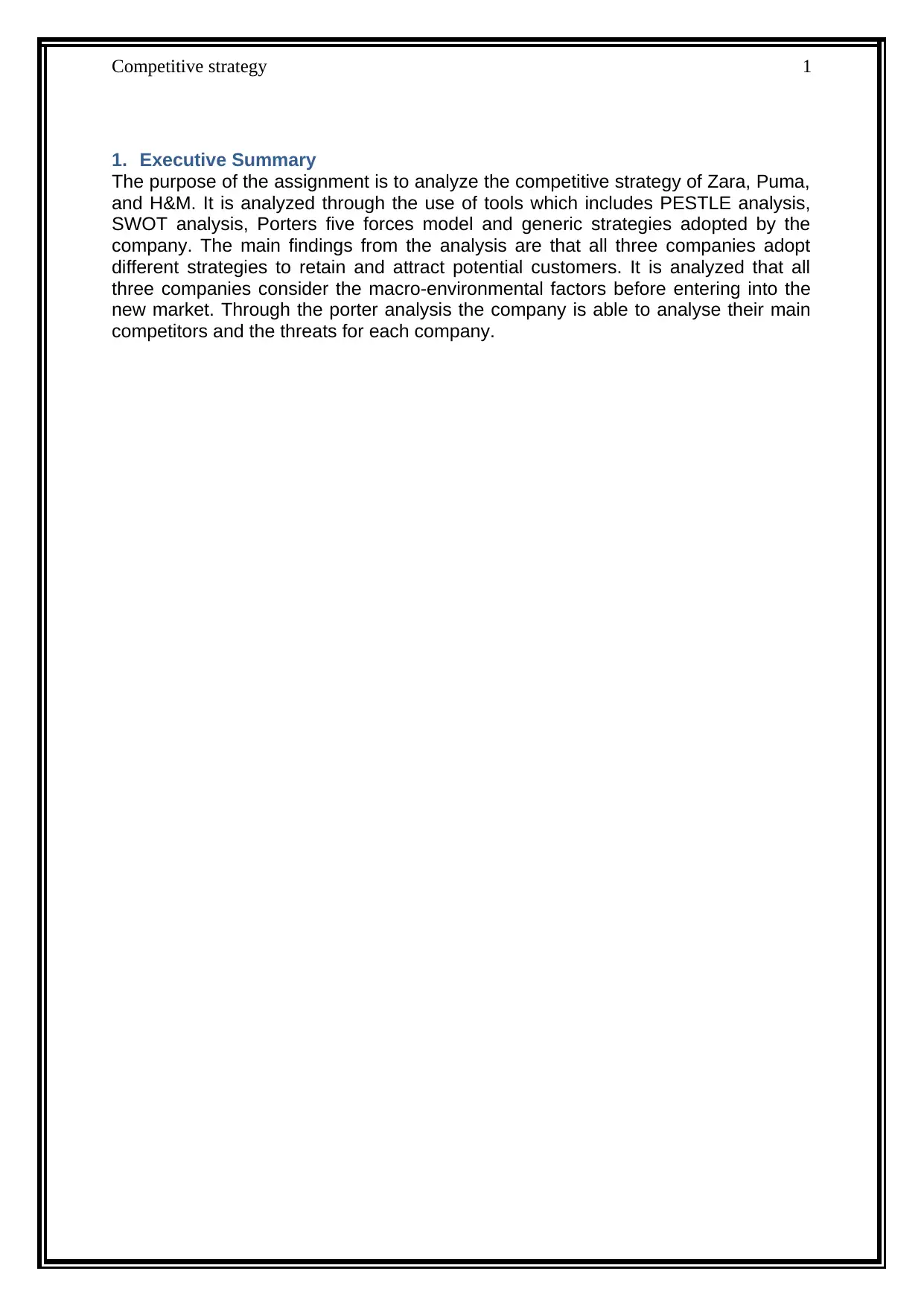
Competitive strategy 1
1. Executive Summary
The purpose of the assignment is to analyze the competitive strategy of Zara, Puma,
and H&M. It is analyzed through the use of tools which includes PESTLE analysis,
SWOT analysis, Porters five forces model and generic strategies adopted by the
company. The main findings from the analysis are that all three companies adopt
different strategies to retain and attract potential customers. It is analyzed that all
three companies consider the macro-environmental factors before entering into the
new market. Through the porter analysis the company is able to analyse their main
competitors and the threats for each company.
1. Executive Summary
The purpose of the assignment is to analyze the competitive strategy of Zara, Puma,
and H&M. It is analyzed through the use of tools which includes PESTLE analysis,
SWOT analysis, Porters five forces model and generic strategies adopted by the
company. The main findings from the analysis are that all three companies adopt
different strategies to retain and attract potential customers. It is analyzed that all
three companies consider the macro-environmental factors before entering into the
new market. Through the porter analysis the company is able to analyse their main
competitors and the threats for each company.

Competitive strategy 2
Contents
1. Executive Summary.........................................................................................................1
2. Introduction..........................................................................................................................3
3. Main Body............................................................................................................................3
3.1. PESTLE Analysis.........................................................................................................3
3.1.1: Theories.................................................................................................................3
3.2. SWOT Analysis............................................................................................................3
3.2.1: Theories.................................................................................................................3
3.3. Porters five force model..............................................................................................4
3.3.1: Theories.................................................................................................................4
3.4. Generic Strategies...........................................................................................................5
3.4.1: Theories.................................................................................................................5
Conclusion................................................................................................................................6
Appendix 1................................................................................................................................7
Appendix 2................................................................................................................................8
Appendix 3..............................................................................................................................10
Contents
1. Executive Summary.........................................................................................................1
2. Introduction..........................................................................................................................3
3. Main Body............................................................................................................................3
3.1. PESTLE Analysis.........................................................................................................3
3.1.1: Theories.................................................................................................................3
3.2. SWOT Analysis............................................................................................................3
3.2.1: Theories.................................................................................................................3
3.3. Porters five force model..............................................................................................4
3.3.1: Theories.................................................................................................................4
3.4. Generic Strategies...........................................................................................................5
3.4.1: Theories.................................................................................................................5
Conclusion................................................................................................................................6
Appendix 1................................................................................................................................7
Appendix 2................................................................................................................................8
Appendix 3..............................................................................................................................10
⊘ This is a preview!⊘
Do you want full access?
Subscribe today to unlock all pages.

Trusted by 1+ million students worldwide
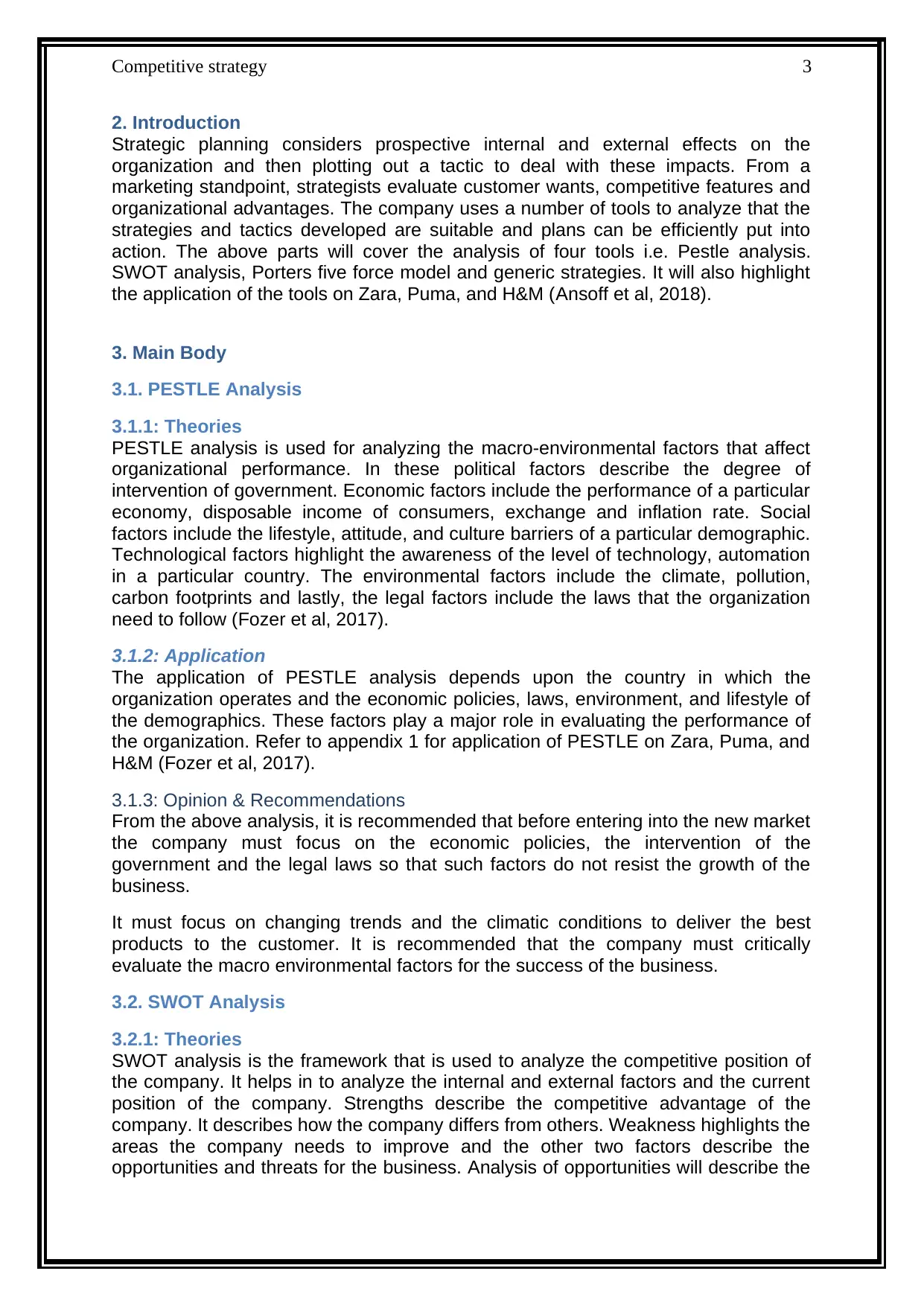
Competitive strategy 3
2. Introduction
Strategic planning considers prospective internal and external effects on the
organization and then plotting out a tactic to deal with these impacts. From a
marketing standpoint, strategists evaluate customer wants, competitive features and
organizational advantages. The company uses a number of tools to analyze that the
strategies and tactics developed are suitable and plans can be efficiently put into
action. The above parts will cover the analysis of four tools i.e. Pestle analysis.
SWOT analysis, Porters five force model and generic strategies. It will also highlight
the application of the tools on Zara, Puma, and H&M (Ansoff et al, 2018).
3. Main Body
3.1. PESTLE Analysis
3.1.1: Theories
PESTLE analysis is used for analyzing the macro-environmental factors that affect
organizational performance. In these political factors describe the degree of
intervention of government. Economic factors include the performance of a particular
economy, disposable income of consumers, exchange and inflation rate. Social
factors include the lifestyle, attitude, and culture barriers of a particular demographic.
Technological factors highlight the awareness of the level of technology, automation
in a particular country. The environmental factors include the climate, pollution,
carbon footprints and lastly, the legal factors include the laws that the organization
need to follow (Fozer et al, 2017).
3.1.2: Application
The application of PESTLE analysis depends upon the country in which the
organization operates and the economic policies, laws, environment, and lifestyle of
the demographics. These factors play a major role in evaluating the performance of
the organization. Refer to appendix 1 for application of PESTLE on Zara, Puma, and
H&M (Fozer et al, 2017).
3.1.3: Opinion & Recommendations
From the above analysis, it is recommended that before entering into the new market
the company must focus on the economic policies, the intervention of the
government and the legal laws so that such factors do not resist the growth of the
business.
It must focus on changing trends and the climatic conditions to deliver the best
products to the customer. It is recommended that the company must critically
evaluate the macro environmental factors for the success of the business.
3.2. SWOT Analysis
3.2.1: Theories
SWOT analysis is the framework that is used to analyze the competitive position of
the company. It helps in to analyze the internal and external factors and the current
position of the company. Strengths describe the competitive advantage of the
company. It describes how the company differs from others. Weakness highlights the
areas the company needs to improve and the other two factors describe the
opportunities and threats for the business. Analysis of opportunities will describe the
2. Introduction
Strategic planning considers prospective internal and external effects on the
organization and then plotting out a tactic to deal with these impacts. From a
marketing standpoint, strategists evaluate customer wants, competitive features and
organizational advantages. The company uses a number of tools to analyze that the
strategies and tactics developed are suitable and plans can be efficiently put into
action. The above parts will cover the analysis of four tools i.e. Pestle analysis.
SWOT analysis, Porters five force model and generic strategies. It will also highlight
the application of the tools on Zara, Puma, and H&M (Ansoff et al, 2018).
3. Main Body
3.1. PESTLE Analysis
3.1.1: Theories
PESTLE analysis is used for analyzing the macro-environmental factors that affect
organizational performance. In these political factors describe the degree of
intervention of government. Economic factors include the performance of a particular
economy, disposable income of consumers, exchange and inflation rate. Social
factors include the lifestyle, attitude, and culture barriers of a particular demographic.
Technological factors highlight the awareness of the level of technology, automation
in a particular country. The environmental factors include the climate, pollution,
carbon footprints and lastly, the legal factors include the laws that the organization
need to follow (Fozer et al, 2017).
3.1.2: Application
The application of PESTLE analysis depends upon the country in which the
organization operates and the economic policies, laws, environment, and lifestyle of
the demographics. These factors play a major role in evaluating the performance of
the organization. Refer to appendix 1 for application of PESTLE on Zara, Puma, and
H&M (Fozer et al, 2017).
3.1.3: Opinion & Recommendations
From the above analysis, it is recommended that before entering into the new market
the company must focus on the economic policies, the intervention of the
government and the legal laws so that such factors do not resist the growth of the
business.
It must focus on changing trends and the climatic conditions to deliver the best
products to the customer. It is recommended that the company must critically
evaluate the macro environmental factors for the success of the business.
3.2. SWOT Analysis
3.2.1: Theories
SWOT analysis is the framework that is used to analyze the competitive position of
the company. It helps in to analyze the internal and external factors and the current
position of the company. Strengths describe the competitive advantage of the
company. It describes how the company differs from others. Weakness highlights the
areas the company needs to improve and the other two factors describe the
opportunities and threats for the business. Analysis of opportunities will describe the
Paraphrase This Document
Need a fresh take? Get an instant paraphrase of this document with our AI Paraphraser
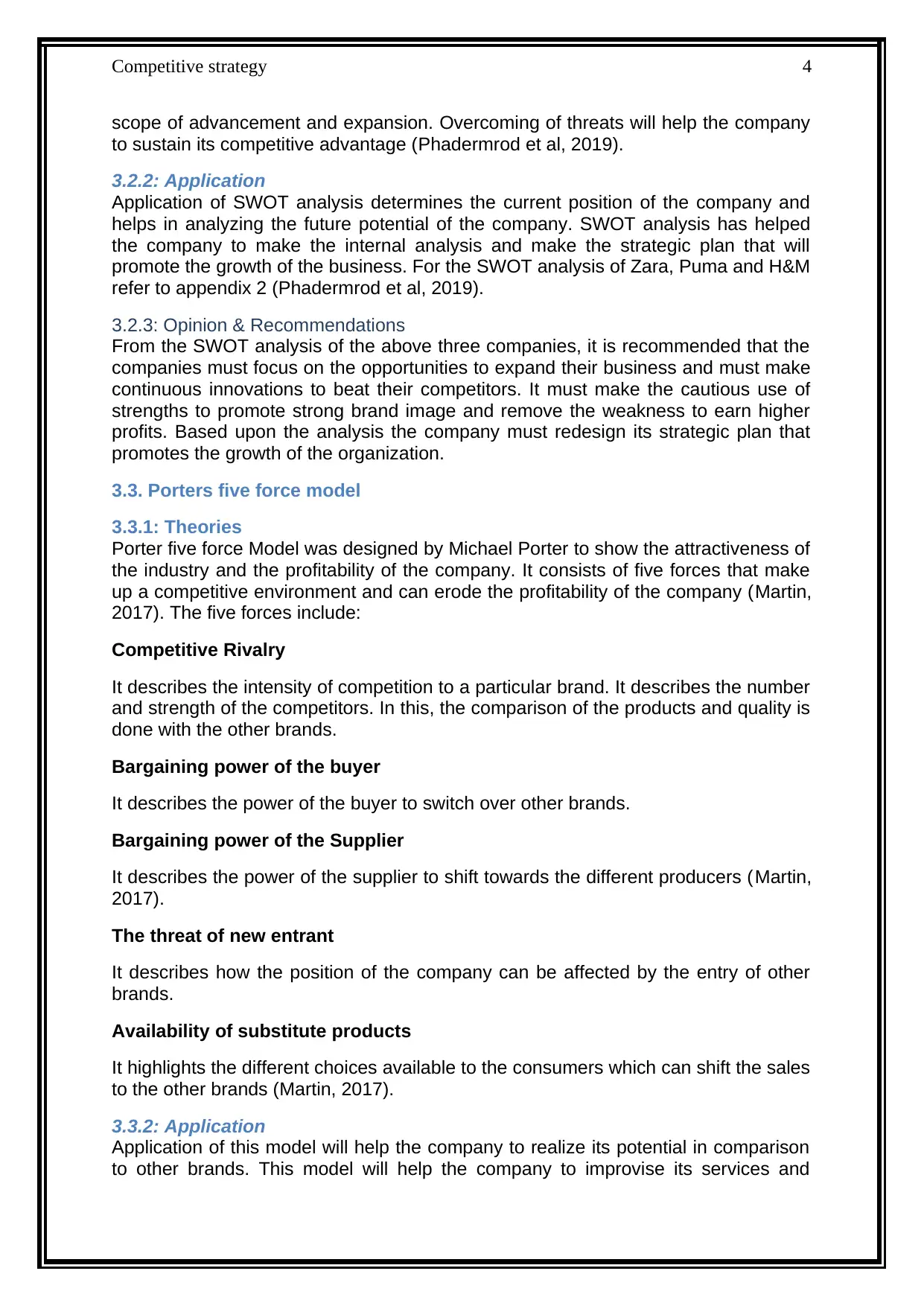
Competitive strategy 4
scope of advancement and expansion. Overcoming of threats will help the company
to sustain its competitive advantage (Phadermrod et al, 2019).
3.2.2: Application
Application of SWOT analysis determines the current position of the company and
helps in analyzing the future potential of the company. SWOT analysis has helped
the company to make the internal analysis and make the strategic plan that will
promote the growth of the business. For the SWOT analysis of Zara, Puma and H&M
refer to appendix 2 (Phadermrod et al, 2019).
3.2.3: Opinion & Recommendations
From the SWOT analysis of the above three companies, it is recommended that the
companies must focus on the opportunities to expand their business and must make
continuous innovations to beat their competitors. It must make the cautious use of
strengths to promote strong brand image and remove the weakness to earn higher
profits. Based upon the analysis the company must redesign its strategic plan that
promotes the growth of the organization.
3.3. Porters five force model
3.3.1: Theories
Porter five force Model was designed by Michael Porter to show the attractiveness of
the industry and the profitability of the company. It consists of five forces that make
up a competitive environment and can erode the profitability of the company (Martin,
2017). The five forces include:
Competitive Rivalry
It describes the intensity of competition to a particular brand. It describes the number
and strength of the competitors. In this, the comparison of the products and quality is
done with the other brands.
Bargaining power of the buyer
It describes the power of the buyer to switch over other brands.
Bargaining power of the Supplier
It describes the power of the supplier to shift towards the different producers (Martin,
2017).
The threat of new entrant
It describes how the position of the company can be affected by the entry of other
brands.
Availability of substitute products
It highlights the different choices available to the consumers which can shift the sales
to the other brands (Martin, 2017).
3.3.2: Application
Application of this model will help the company to realize its potential in comparison
to other brands. This model will help the company to improvise its services and
scope of advancement and expansion. Overcoming of threats will help the company
to sustain its competitive advantage (Phadermrod et al, 2019).
3.2.2: Application
Application of SWOT analysis determines the current position of the company and
helps in analyzing the future potential of the company. SWOT analysis has helped
the company to make the internal analysis and make the strategic plan that will
promote the growth of the business. For the SWOT analysis of Zara, Puma and H&M
refer to appendix 2 (Phadermrod et al, 2019).
3.2.3: Opinion & Recommendations
From the SWOT analysis of the above three companies, it is recommended that the
companies must focus on the opportunities to expand their business and must make
continuous innovations to beat their competitors. It must make the cautious use of
strengths to promote strong brand image and remove the weakness to earn higher
profits. Based upon the analysis the company must redesign its strategic plan that
promotes the growth of the organization.
3.3. Porters five force model
3.3.1: Theories
Porter five force Model was designed by Michael Porter to show the attractiveness of
the industry and the profitability of the company. It consists of five forces that make
up a competitive environment and can erode the profitability of the company (Martin,
2017). The five forces include:
Competitive Rivalry
It describes the intensity of competition to a particular brand. It describes the number
and strength of the competitors. In this, the comparison of the products and quality is
done with the other brands.
Bargaining power of the buyer
It describes the power of the buyer to switch over other brands.
Bargaining power of the Supplier
It describes the power of the supplier to shift towards the different producers (Martin,
2017).
The threat of new entrant
It describes how the position of the company can be affected by the entry of other
brands.
Availability of substitute products
It highlights the different choices available to the consumers which can shift the sales
to the other brands (Martin, 2017).
3.3.2: Application
Application of this model will help the company to realize its potential in comparison
to other brands. This model will help the company to improvise its services and
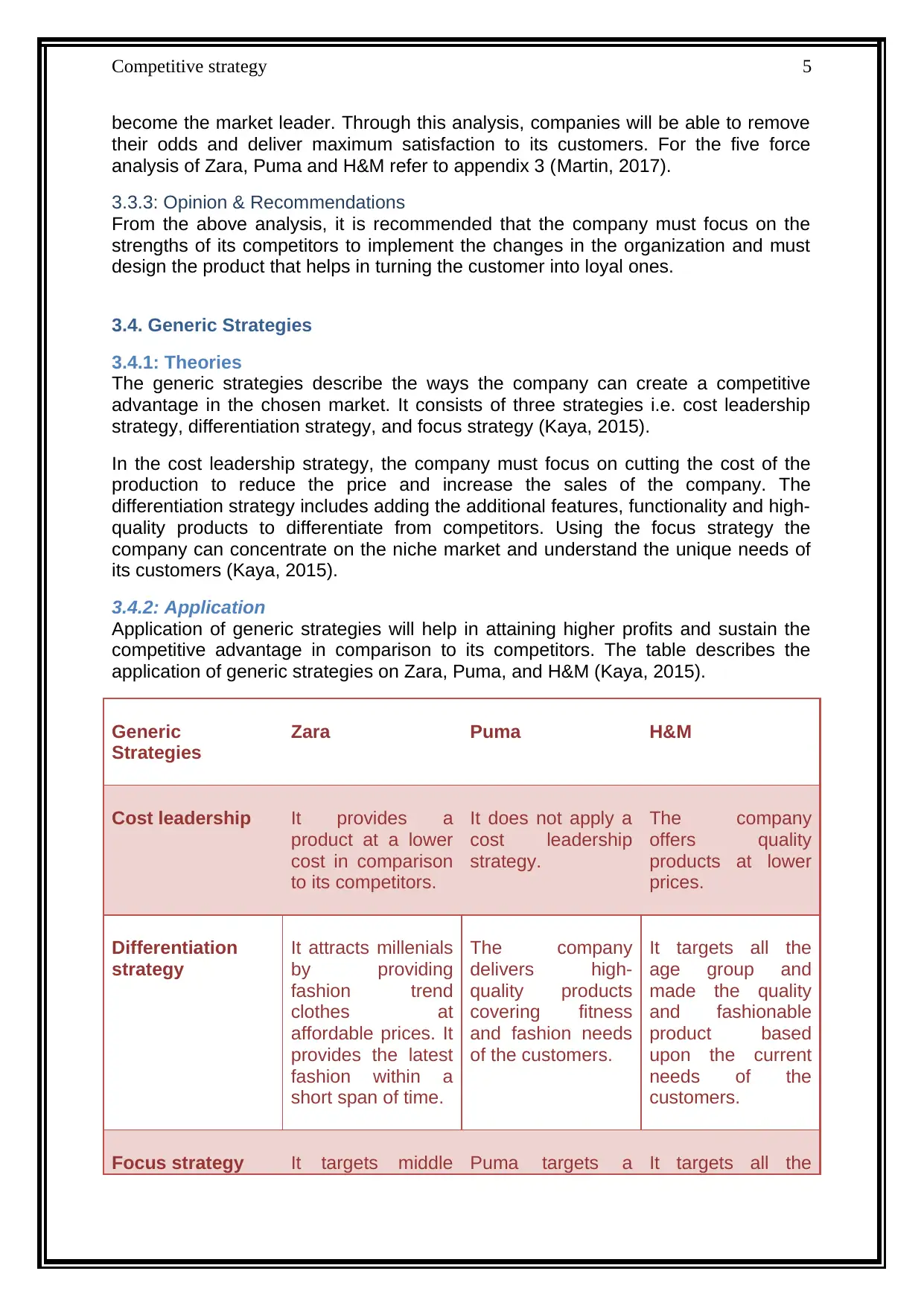
Competitive strategy 5
become the market leader. Through this analysis, companies will be able to remove
their odds and deliver maximum satisfaction to its customers. For the five force
analysis of Zara, Puma and H&M refer to appendix 3 (Martin, 2017).
3.3.3: Opinion & Recommendations
From the above analysis, it is recommended that the company must focus on the
strengths of its competitors to implement the changes in the organization and must
design the product that helps in turning the customer into loyal ones.
3.4. Generic Strategies
3.4.1: Theories
The generic strategies describe the ways the company can create a competitive
advantage in the chosen market. It consists of three strategies i.e. cost leadership
strategy, differentiation strategy, and focus strategy (Kaya, 2015).
In the cost leadership strategy, the company must focus on cutting the cost of the
production to reduce the price and increase the sales of the company. The
differentiation strategy includes adding the additional features, functionality and high-
quality products to differentiate from competitors. Using the focus strategy the
company can concentrate on the niche market and understand the unique needs of
its customers (Kaya, 2015).
3.4.2: Application
Application of generic strategies will help in attaining higher profits and sustain the
competitive advantage in comparison to its competitors. The table describes the
application of generic strategies on Zara, Puma, and H&M (Kaya, 2015).
Generic
Strategies
Zara Puma H&M
Cost leadership It provides a
product at a lower
cost in comparison
to its competitors.
It does not apply a
cost leadership
strategy.
The company
offers quality
products at lower
prices.
Differentiation
strategy
It attracts millenials
by providing
fashion trend
clothes at
affordable prices. It
provides the latest
fashion within a
short span of time.
The company
delivers high-
quality products
covering fitness
and fashion needs
of the customers.
It targets all the
age group and
made the quality
and fashionable
product based
upon the current
needs of the
customers.
Focus strategy It targets middle Puma targets a It targets all the
become the market leader. Through this analysis, companies will be able to remove
their odds and deliver maximum satisfaction to its customers. For the five force
analysis of Zara, Puma and H&M refer to appendix 3 (Martin, 2017).
3.3.3: Opinion & Recommendations
From the above analysis, it is recommended that the company must focus on the
strengths of its competitors to implement the changes in the organization and must
design the product that helps in turning the customer into loyal ones.
3.4. Generic Strategies
3.4.1: Theories
The generic strategies describe the ways the company can create a competitive
advantage in the chosen market. It consists of three strategies i.e. cost leadership
strategy, differentiation strategy, and focus strategy (Kaya, 2015).
In the cost leadership strategy, the company must focus on cutting the cost of the
production to reduce the price and increase the sales of the company. The
differentiation strategy includes adding the additional features, functionality and high-
quality products to differentiate from competitors. Using the focus strategy the
company can concentrate on the niche market and understand the unique needs of
its customers (Kaya, 2015).
3.4.2: Application
Application of generic strategies will help in attaining higher profits and sustain the
competitive advantage in comparison to its competitors. The table describes the
application of generic strategies on Zara, Puma, and H&M (Kaya, 2015).
Generic
Strategies
Zara Puma H&M
Cost leadership It provides a
product at a lower
cost in comparison
to its competitors.
It does not apply a
cost leadership
strategy.
The company
offers quality
products at lower
prices.
Differentiation
strategy
It attracts millenials
by providing
fashion trend
clothes at
affordable prices. It
provides the latest
fashion within a
short span of time.
The company
delivers high-
quality products
covering fitness
and fashion needs
of the customers.
It targets all the
age group and
made the quality
and fashionable
product based
upon the current
needs of the
customers.
Focus strategy It targets middle Puma targets a It targets all the
⊘ This is a preview!⊘
Do you want full access?
Subscribe today to unlock all pages.

Trusted by 1+ million students worldwide
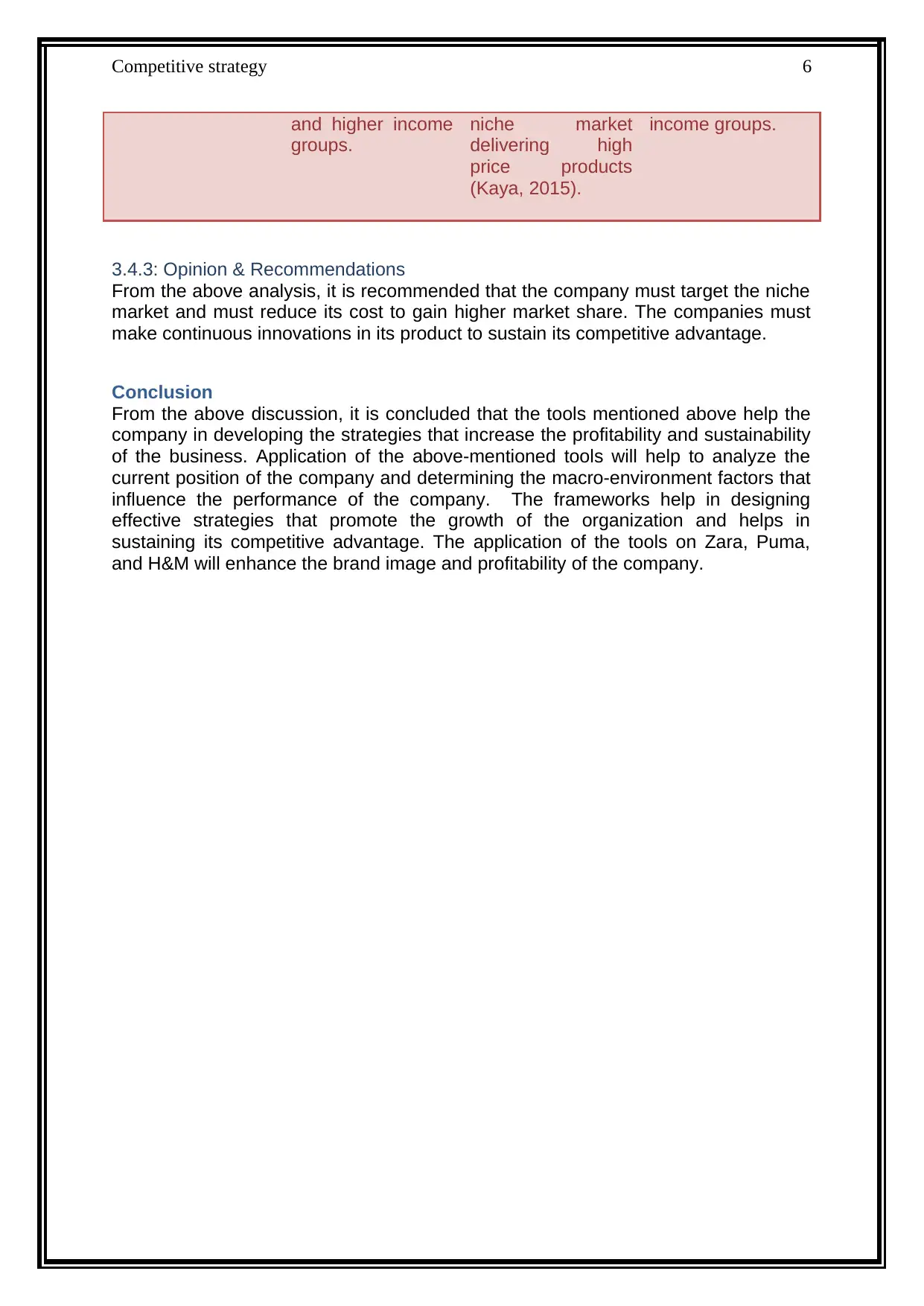
Competitive strategy 6
and higher income
groups.
niche market
delivering high
price products
(Kaya, 2015).
income groups.
3.4.3: Opinion & Recommendations
From the above analysis, it is recommended that the company must target the niche
market and must reduce its cost to gain higher market share. The companies must
make continuous innovations in its product to sustain its competitive advantage.
Conclusion
From the above discussion, it is concluded that the tools mentioned above help the
company in developing the strategies that increase the profitability and sustainability
of the business. Application of the above-mentioned tools will help to analyze the
current position of the company and determining the macro-environment factors that
influence the performance of the company. The frameworks help in designing
effective strategies that promote the growth of the organization and helps in
sustaining its competitive advantage. The application of the tools on Zara, Puma,
and H&M will enhance the brand image and profitability of the company.
and higher income
groups.
niche market
delivering high
price products
(Kaya, 2015).
income groups.
3.4.3: Opinion & Recommendations
From the above analysis, it is recommended that the company must target the niche
market and must reduce its cost to gain higher market share. The companies must
make continuous innovations in its product to sustain its competitive advantage.
Conclusion
From the above discussion, it is concluded that the tools mentioned above help the
company in developing the strategies that increase the profitability and sustainability
of the business. Application of the above-mentioned tools will help to analyze the
current position of the company and determining the macro-environment factors that
influence the performance of the company. The frameworks help in designing
effective strategies that promote the growth of the organization and helps in
sustaining its competitive advantage. The application of the tools on Zara, Puma,
and H&M will enhance the brand image and profitability of the company.
Paraphrase This Document
Need a fresh take? Get an instant paraphrase of this document with our AI Paraphraser
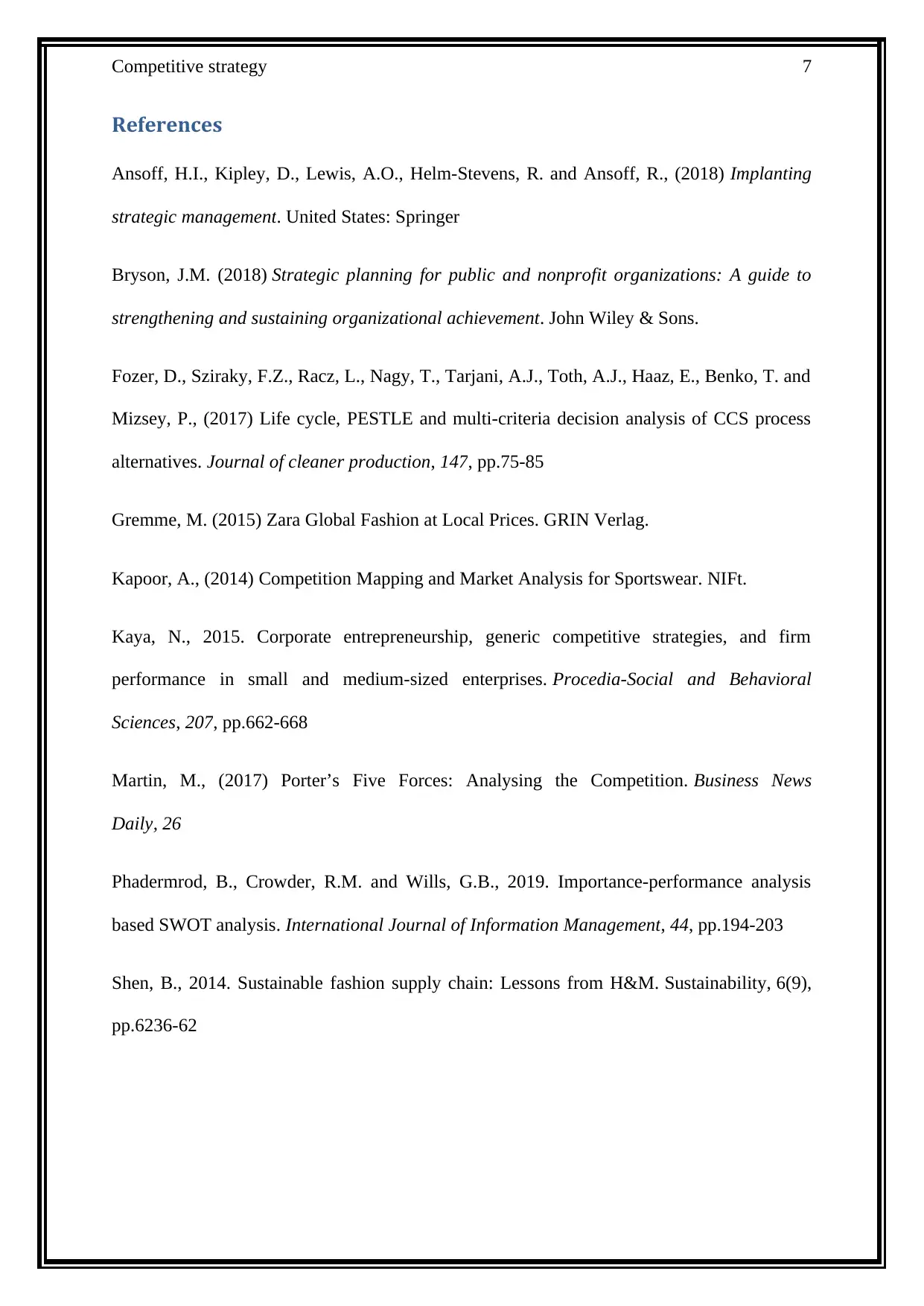
Competitive strategy 7
References
Ansoff, H.I., Kipley, D., Lewis, A.O., Helm-Stevens, R. and Ansoff, R., (2018) Implanting
strategic management. United States: Springer
Bryson, J.M. (2018) Strategic planning for public and nonprofit organizations: A guide to
strengthening and sustaining organizational achievement. John Wiley & Sons.
Fozer, D., Sziraky, F.Z., Racz, L., Nagy, T., Tarjani, A.J., Toth, A.J., Haaz, E., Benko, T. and
Mizsey, P., (2017) Life cycle, PESTLE and multi-criteria decision analysis of CCS process
alternatives. Journal of cleaner production, 147, pp.75-85
Gremme, M. (2015) Zara Global Fashion at Local Prices. GRIN Verlag.
Kapoor, A., (2014) Competition Mapping and Market Analysis for Sportswear. NIFt.
Kaya, N., 2015. Corporate entrepreneurship, generic competitive strategies, and firm
performance in small and medium-sized enterprises. Procedia-Social and Behavioral
Sciences, 207, pp.662-668
Martin, M., (2017) Porter’s Five Forces: Analysing the Competition. Business News
Daily, 26
Phadermrod, B., Crowder, R.M. and Wills, G.B., 2019. Importance-performance analysis
based SWOT analysis. International Journal of Information Management, 44, pp.194-203
Shen, B., 2014. Sustainable fashion supply chain: Lessons from H&M. Sustainability, 6(9),
pp.6236-62
References
Ansoff, H.I., Kipley, D., Lewis, A.O., Helm-Stevens, R. and Ansoff, R., (2018) Implanting
strategic management. United States: Springer
Bryson, J.M. (2018) Strategic planning for public and nonprofit organizations: A guide to
strengthening and sustaining organizational achievement. John Wiley & Sons.
Fozer, D., Sziraky, F.Z., Racz, L., Nagy, T., Tarjani, A.J., Toth, A.J., Haaz, E., Benko, T. and
Mizsey, P., (2017) Life cycle, PESTLE and multi-criteria decision analysis of CCS process
alternatives. Journal of cleaner production, 147, pp.75-85
Gremme, M. (2015) Zara Global Fashion at Local Prices. GRIN Verlag.
Kapoor, A., (2014) Competition Mapping and Market Analysis for Sportswear. NIFt.
Kaya, N., 2015. Corporate entrepreneurship, generic competitive strategies, and firm
performance in small and medium-sized enterprises. Procedia-Social and Behavioral
Sciences, 207, pp.662-668
Martin, M., (2017) Porter’s Five Forces: Analysing the Competition. Business News
Daily, 26
Phadermrod, B., Crowder, R.M. and Wills, G.B., 2019. Importance-performance analysis
based SWOT analysis. International Journal of Information Management, 44, pp.194-203
Shen, B., 2014. Sustainable fashion supply chain: Lessons from H&M. Sustainability, 6(9),
pp.6236-62
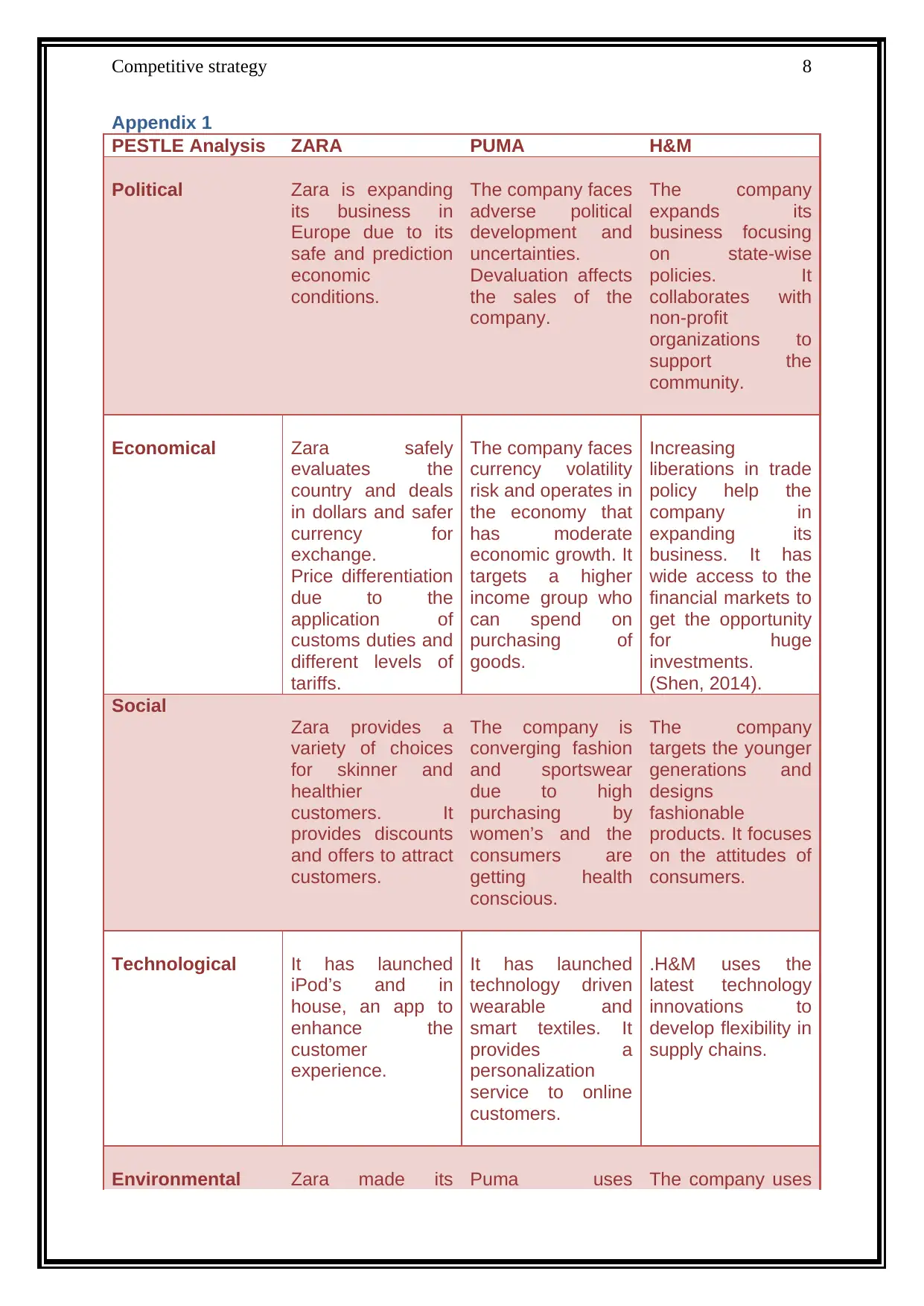
Competitive strategy 8
Appendix 1
PESTLE Analysis ZARA PUMA H&M
Political Zara is expanding
its business in
Europe due to its
safe and prediction
economic
conditions.
The company faces
adverse political
development and
uncertainties.
Devaluation affects
the sales of the
company.
The company
expands its
business focusing
on state-wise
policies. It
collaborates with
non-profit
organizations to
support the
community.
Economical Zara safely
evaluates the
country and deals
in dollars and safer
currency for
exchange.
Price differentiation
due to the
application of
customs duties and
different levels of
tariffs.
The company faces
currency volatility
risk and operates in
the economy that
has moderate
economic growth. It
targets a higher
income group who
can spend on
purchasing of
goods.
Increasing
liberations in trade
policy help the
company in
expanding its
business. It has
wide access to the
financial markets to
get the opportunity
for huge
investments.
(Shen, 2014).
Social
Zara provides a
variety of choices
for skinner and
healthier
customers. It
provides discounts
and offers to attract
customers.
The company is
converging fashion
and sportswear
due to high
purchasing by
women’s and the
consumers are
getting health
conscious.
The company
targets the younger
generations and
designs
fashionable
products. It focuses
on the attitudes of
consumers.
Technological It has launched
iPod’s and in
house, an app to
enhance the
customer
experience.
It has launched
technology driven
wearable and
smart textiles. It
provides a
personalization
service to online
customers.
.H&M uses the
latest technology
innovations to
develop flexibility in
supply chains.
Environmental Zara made its Puma uses The company uses
Appendix 1
PESTLE Analysis ZARA PUMA H&M
Political Zara is expanding
its business in
Europe due to its
safe and prediction
economic
conditions.
The company faces
adverse political
development and
uncertainties.
Devaluation affects
the sales of the
company.
The company
expands its
business focusing
on state-wise
policies. It
collaborates with
non-profit
organizations to
support the
community.
Economical Zara safely
evaluates the
country and deals
in dollars and safer
currency for
exchange.
Price differentiation
due to the
application of
customs duties and
different levels of
tariffs.
The company faces
currency volatility
risk and operates in
the economy that
has moderate
economic growth. It
targets a higher
income group who
can spend on
purchasing of
goods.
Increasing
liberations in trade
policy help the
company in
expanding its
business. It has
wide access to the
financial markets to
get the opportunity
for huge
investments.
(Shen, 2014).
Social
Zara provides a
variety of choices
for skinner and
healthier
customers. It
provides discounts
and offers to attract
customers.
The company is
converging fashion
and sportswear
due to high
purchasing by
women’s and the
consumers are
getting health
conscious.
The company
targets the younger
generations and
designs
fashionable
products. It focuses
on the attitudes of
consumers.
Technological It has launched
iPod’s and in
house, an app to
enhance the
customer
experience.
It has launched
technology driven
wearable and
smart textiles. It
provides a
personalization
service to online
customers.
.H&M uses the
latest technology
innovations to
develop flexibility in
supply chains.
Environmental Zara made its Puma uses The company uses
⊘ This is a preview!⊘
Do you want full access?
Subscribe today to unlock all pages.

Trusted by 1+ million students worldwide

Competitive strategy 9
product
considering normal
weather to face the
rapid changes in
the climate of
western countries.
sustainable raw
material and has
FSC certified
shoebox,
handbags.
flexible supply
chains to change
the trends
according to
changing the
climate. It uses
recyclable
resources (Bryson,
2018).
Legal
The company
faces litigation and
copyright issues.
The company has
a strong
compliance
management
system.
It abides various
laws such as
employment law,
environmental
laws, copyrights,
and intellectual
laws.
Appendix 2
SWOT Analysis ZARA PUMA H&M
Strengths It has strong
control over the
supply chain and
imitates season to
bring the fashion
trend. The
company does not
outsource its
product and has
efficient production
management. The
network of Zara is
largely distributed
and has a wide
reach.
The company has
strong brand
positioning and is
well recognized for
its quality and
range. It has strong
customer
relationship
marketing by
providing various
amenities t
customers.
The company
enjoys strong
financial
performance and
has a diversified
network. The
company provides
a variety of
products and has a
unique identity of
the brand.
product
considering normal
weather to face the
rapid changes in
the climate of
western countries.
sustainable raw
material and has
FSC certified
shoebox,
handbags.
flexible supply
chains to change
the trends
according to
changing the
climate. It uses
recyclable
resources (Bryson,
2018).
Legal
The company
faces litigation and
copyright issues.
The company has
a strong
compliance
management
system.
It abides various
laws such as
employment law,
environmental
laws, copyrights,
and intellectual
laws.
Appendix 2
SWOT Analysis ZARA PUMA H&M
Strengths It has strong
control over the
supply chain and
imitates season to
bring the fashion
trend. The
company does not
outsource its
product and has
efficient production
management. The
network of Zara is
largely distributed
and has a wide
reach.
The company has
strong brand
positioning and is
well recognized for
its quality and
range. It has strong
customer
relationship
marketing by
providing various
amenities t
customers.
The company
enjoys strong
financial
performance and
has a diversified
network. The
company provides
a variety of
products and has a
unique identity of
the brand.
Paraphrase This Document
Need a fresh take? Get an instant paraphrase of this document with our AI Paraphraser
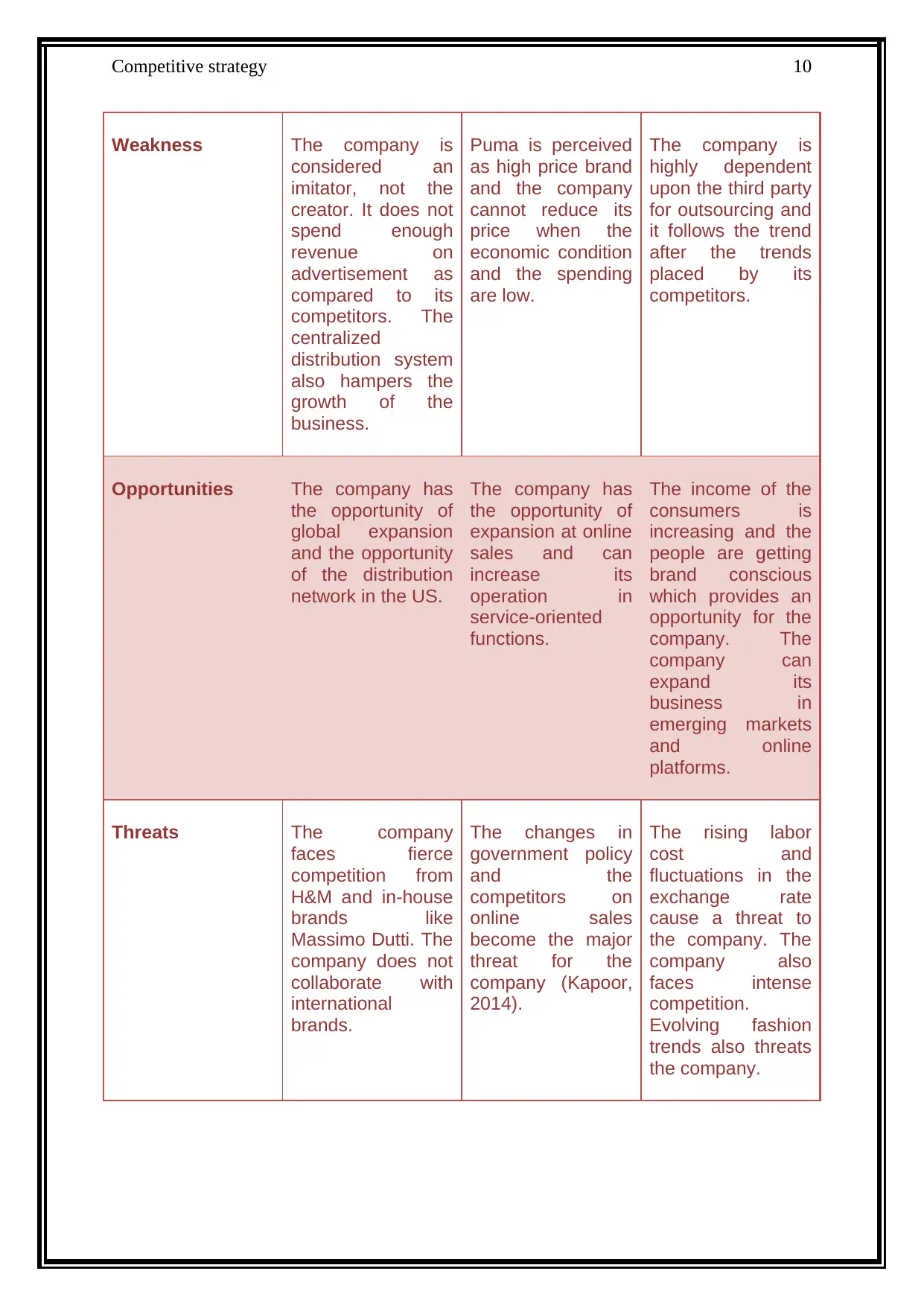
Competitive strategy 10
Weakness The company is
considered an
imitator, not the
creator. It does not
spend enough
revenue on
advertisement as
compared to its
competitors. The
centralized
distribution system
also hampers the
growth of the
business.
Puma is perceived
as high price brand
and the company
cannot reduce its
price when the
economic condition
and the spending
are low.
The company is
highly dependent
upon the third party
for outsourcing and
it follows the trend
after the trends
placed by its
competitors.
Opportunities The company has
the opportunity of
global expansion
and the opportunity
of the distribution
network in the US.
The company has
the opportunity of
expansion at online
sales and can
increase its
operation in
service-oriented
functions.
The income of the
consumers is
increasing and the
people are getting
brand conscious
which provides an
opportunity for the
company. The
company can
expand its
business in
emerging markets
and online
platforms.
Threats The company
faces fierce
competition from
H&M and in-house
brands like
Massimo Dutti. The
company does not
collaborate with
international
brands.
The changes in
government policy
and the
competitors on
online sales
become the major
threat for the
company (Kapoor,
2014).
The rising labor
cost and
fluctuations in the
exchange rate
cause a threat to
the company. The
company also
faces intense
competition.
Evolving fashion
trends also threats
the company.
Weakness The company is
considered an
imitator, not the
creator. It does not
spend enough
revenue on
advertisement as
compared to its
competitors. The
centralized
distribution system
also hampers the
growth of the
business.
Puma is perceived
as high price brand
and the company
cannot reduce its
price when the
economic condition
and the spending
are low.
The company is
highly dependent
upon the third party
for outsourcing and
it follows the trend
after the trends
placed by its
competitors.
Opportunities The company has
the opportunity of
global expansion
and the opportunity
of the distribution
network in the US.
The company has
the opportunity of
expansion at online
sales and can
increase its
operation in
service-oriented
functions.
The income of the
consumers is
increasing and the
people are getting
brand conscious
which provides an
opportunity for the
company. The
company can
expand its
business in
emerging markets
and online
platforms.
Threats The company
faces fierce
competition from
H&M and in-house
brands like
Massimo Dutti. The
company does not
collaborate with
international
brands.
The changes in
government policy
and the
competitors on
online sales
become the major
threat for the
company (Kapoor,
2014).
The rising labor
cost and
fluctuations in the
exchange rate
cause a threat to
the company. The
company also
faces intense
competition.
Evolving fashion
trends also threats
the company.
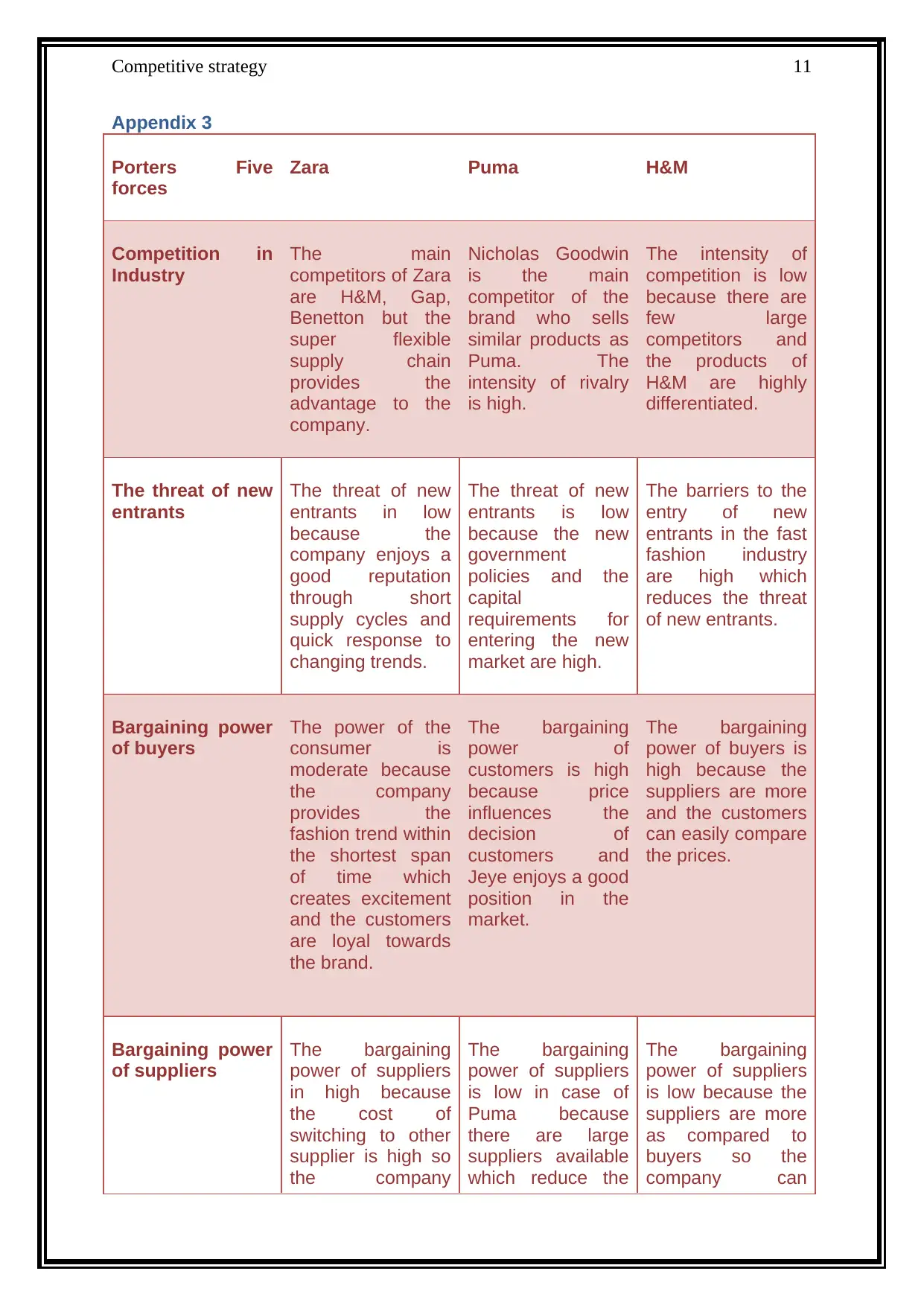
Competitive strategy 11
Appendix 3
Porters Five
forces
Zara Puma H&M
Competition in
Industry
The main
competitors of Zara
are H&M, Gap,
Benetton but the
super flexible
supply chain
provides the
advantage to the
company.
Nicholas Goodwin
is the main
competitor of the
brand who sells
similar products as
Puma. The
intensity of rivalry
is high.
The intensity of
competition is low
because there are
few large
competitors and
the products of
H&M are highly
differentiated.
The threat of new
entrants
The threat of new
entrants in low
because the
company enjoys a
good reputation
through short
supply cycles and
quick response to
changing trends.
The threat of new
entrants is low
because the new
government
policies and the
capital
requirements for
entering the new
market are high.
The barriers to the
entry of new
entrants in the fast
fashion industry
are high which
reduces the threat
of new entrants.
Bargaining power
of buyers
The power of the
consumer is
moderate because
the company
provides the
fashion trend within
the shortest span
of time which
creates excitement
and the customers
are loyal towards
the brand.
The bargaining
power of
customers is high
because price
influences the
decision of
customers and
Jeye enjoys a good
position in the
market.
The bargaining
power of buyers is
high because the
suppliers are more
and the customers
can easily compare
the prices.
Bargaining power
of suppliers
The bargaining
power of suppliers
in high because
the cost of
switching to other
supplier is high so
the company
The bargaining
power of suppliers
is low in case of
Puma because
there are large
suppliers available
which reduce the
The bargaining
power of suppliers
is low because the
suppliers are more
as compared to
buyers so the
company can
Appendix 3
Porters Five
forces
Zara Puma H&M
Competition in
Industry
The main
competitors of Zara
are H&M, Gap,
Benetton but the
super flexible
supply chain
provides the
advantage to the
company.
Nicholas Goodwin
is the main
competitor of the
brand who sells
similar products as
Puma. The
intensity of rivalry
is high.
The intensity of
competition is low
because there are
few large
competitors and
the products of
H&M are highly
differentiated.
The threat of new
entrants
The threat of new
entrants in low
because the
company enjoys a
good reputation
through short
supply cycles and
quick response to
changing trends.
The threat of new
entrants is low
because the new
government
policies and the
capital
requirements for
entering the new
market are high.
The barriers to the
entry of new
entrants in the fast
fashion industry
are high which
reduces the threat
of new entrants.
Bargaining power
of buyers
The power of the
consumer is
moderate because
the company
provides the
fashion trend within
the shortest span
of time which
creates excitement
and the customers
are loyal towards
the brand.
The bargaining
power of
customers is high
because price
influences the
decision of
customers and
Jeye enjoys a good
position in the
market.
The bargaining
power of buyers is
high because the
suppliers are more
and the customers
can easily compare
the prices.
Bargaining power
of suppliers
The bargaining
power of suppliers
in high because
the cost of
switching to other
supplier is high so
the company
The bargaining
power of suppliers
is low in case of
Puma because
there are large
suppliers available
which reduce the
The bargaining
power of suppliers
is low because the
suppliers are more
as compared to
buyers so the
company can
⊘ This is a preview!⊘
Do you want full access?
Subscribe today to unlock all pages.

Trusted by 1+ million students worldwide
1 out of 14
Related Documents
Your All-in-One AI-Powered Toolkit for Academic Success.
+13062052269
info@desklib.com
Available 24*7 on WhatsApp / Email
![[object Object]](/_next/static/media/star-bottom.7253800d.svg)
Unlock your academic potential
Copyright © 2020–2025 A2Z Services. All Rights Reserved. Developed and managed by ZUCOL.





